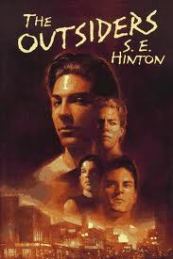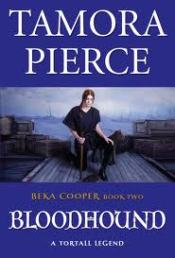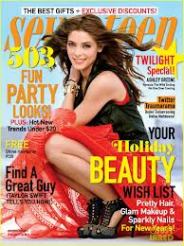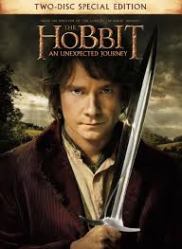
The Outsiders by S. E. Hinton ISBN 978-0142407332, Speak; PLATINUM EDITION edition (April 20, 2006)
Plot Summary:
Ponyboy Curtis has lived with his older brother, Sodapop, under the guardianship of their eldest brother, Darry, ever since their parents died in a car crash. Ponyboy, Sodapop, and Darry are greasers as are all of their friends. Greasers are lower class boys who wear their hair greased back, and are rivals with the Socs, short for socials, who are upper middle class kids who live on the West side of town. Animosity between the two groups heightens when Ponyboy and his friend Johnny strike up a conversation with two Soc girls, Cherry and Marcia, at a movie. Ponyboy and Johnny offer to walk the girls to a friend’s house where they can get a ride home and they are intercepted by the girl’s drunken boyfriends, Bob and Randy. Later that night, Ponyboy gets into a fight with Darry and meets up with Johnny in a park. Unfortunately, Bob, Randy and several of their Soc friends also show up at the same park and after the events of that night, things will never be the same for either group.
Critical Evaluation:
S.E. Hinton’s novel, The Outsiders, is filled with memorable characters with crazy names like Ponyboy and Sodapop. For the most part, the Greasers are poor, high school dropouts who regularly engage in illegal activity. They are also fiercely loyal, have a code of honor and a great sense of camaraderie within their group. Dally Winston is the epitome of his image. A hood who is in and out of jail, but who once took the fall for a friend for a crime he did not commit. Dally is also the one that Ponyboy and Johnny turn to when they get into trouble. Although vilified at first, the Socs also possess good qualities. Through the eyes of Ponyboy, and the conversation between Ponyboy and Johnny and two Soc girls, the reader also comes to realize that while Socs may not have to worry about money, they do have to deal with their own problems, and the same sort of worries that everyone, everywhere has to deal with.
Information about the author:
Susan Eloise Hinton was born in Tulsa, Oklahoma. She has always enjoyed reading but wasn’t satisfied with the literature that was being written for young adults, which influenced her to write novels like The Outsiders. That book, her first novel, was published in 1967 by Viking.
Once published, The Outsiders gave her a lot of publicity and fame, and also a lot of pressure. S.E. Hinton was becoming known as “The Voice of the Youth” among other titles. This kind of pressure and publicity resulted in a three year long writer’s block.
Her boyfriend (and now, her husband),who had gotten sick of her being depressed all the time, eventually broke this block. He made her write two pages a day if she wanted to go anywhere. This eventually led to That Was Then, This Is Now.
That Was Then, This Is Now is known to be a much more well thought out book than The Outsiders. Because she read a lot of great literature and wanted to better herself, she made sure that she wrote each sentence exactly right. She continued to write her two pages a day until she finally felt it was finished in the summer of 1970, she got married a few months later. That Was Then, This is Now was published in 1971.
In 1975, S.E. Hinton published Rumble Fish as a novel (she had published a short story version in a 1968 edition of Nimrod, which was a literary supplement for the University of Tulsa Alumni Magazine).
Rumble Fish was the shortest novel she had published. It received a great deal of contrasting opinions, with one reviewer claiming it to be her best book and the next claiming it to be her last.
The latter was apparently wrong. Tex was published in 1979, four years after Rumble Fish. It received great reviews and people raved about how the writing style had matured since previous publications. Tex would be the last book S.E. Hinton published for nine years. After another span of four years, S.E. Hinton’s son, Nick was born.
Four years after Tex was released, quite a few major events took place in S.E. Hinton’s life. In March of 1983, the movie The Outsiders was released. The following August, Nicholas David was born. Two months later the movie Rumble Fish was released.
In 1985 the movie version of That Was Then, This Is Now was released. Three years later S.E. Hinton became the first person to receive the YASD/SLJ Author Achievement Award, which was given by the Young Adult Services Division of the American Library Association and School Library Journal.
Taming The Star Runner was released in October of that year. It was the first book that S.E. Hinton had published that wasn’t in first person. With a seven-year wait, S.E. Hinton released another book in 1995. This time she did something that no one expected.
Big David, Little David was written for children around the kindergarten age. This deviation from Teen fiction seems to be a reflection of the current important things in S.E. Hinton’s life: Family. The children’s fiction trend continues with her latest release- The Puppy Sister, which is a fantasy book written for Elementary school level children.
S.E. Hinton currently lives in Tulsa, Oklahoma with her husband David. Her son Nick is away for college.
Reader’s Annotation:
There has always been animosity between the greasers and the socs, but it is not until the lines get blurred that the violence escalates.
Genre:
Realistic Fiction.
Curriculum Ties:
N/A
Booktalking Ideas:
Describe cliques in the Fifties compared to cliques today.
Reading Level/Interest Age:
Grades 7 and up
Challenge Issues:
Violence.
I would make sure that all material was purchased in accordance with my library’s collection development policy and make sure to keep a file containing positive reviews for books that I thought might be challenged. In the event of a challenge, I would actively listen to the parent’s concern and ask if they had read the book. I would then explain why the book had been added to the collection and provide with the reviews and a copy of the collection development policy. I would affirm that they are within their rights to limit what their children read, but that other parents also have the right to determine what their children can read. If all else failed, I would provide the parent with a reconsideration form.
Reasons for inclusion:
No young adult collection would be complete with out it.








